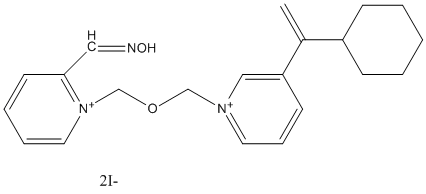HGG-42
General
Type : Hagedorn Oxime, Oxime
Chemical_Nomenclature : Pyridinium, 1-(((3-(cyclohexylcarbonyl)pyridinio)methoxy)methyl)-2-((hydroxyimino)methyl)-, diiodide, [(E)-[1-[[3-(cyclohexanecarbonyl)pyridin-1-ium-1-yl]methoxymethyl]pyridin-2-ylidene]methyl]-oxoazanium\;diiodide
Canonical SMILES : C1CCC(CC1)C(=O)C2=C[N+](=CC=C2)COCN3C=CC=CC3=C[NH+]=O.[I-].[I-]
InChI : InChI=1S\/C20H24N3O3.2HI\/c24-20(17-7-2-1-3-8-17)18-9-6-11-22(14-18)15-26-16-23-12-5-4-10-19(23)13-21-25\;\;\/h4-6,9-14,17H,1-3,7-8,15-16H2\;2*1H\/q+1\;\;\/p-1\/b19-13+\;\;
InChIKey : RDBMYWFOYBVFPS-BWSKXRJVSA-M
Other name(s) : Hgg 42, BDB 15, Pyridinium, 1-(((3-(cyclohexylcarbonyl)pyridinio)methoxy)methyl)-2-((hydroxyimino)methyl)-, diiodide, Pyridinium, 3'-cyclohexylcarbonyl-2-formyl-1,1'-(oxydimethylene)di-, diiodide, 2-oxime, monohydrate, AC1NUR5D
MW : 609.23
Formula : C20H25I2N3O3
CAS_number : 65320-92-5
CID PubChem :
InChIKey UniChem :
Iuphar :
Wikipedia :

Target
Structure : No structure
Families : No family
References
No reference